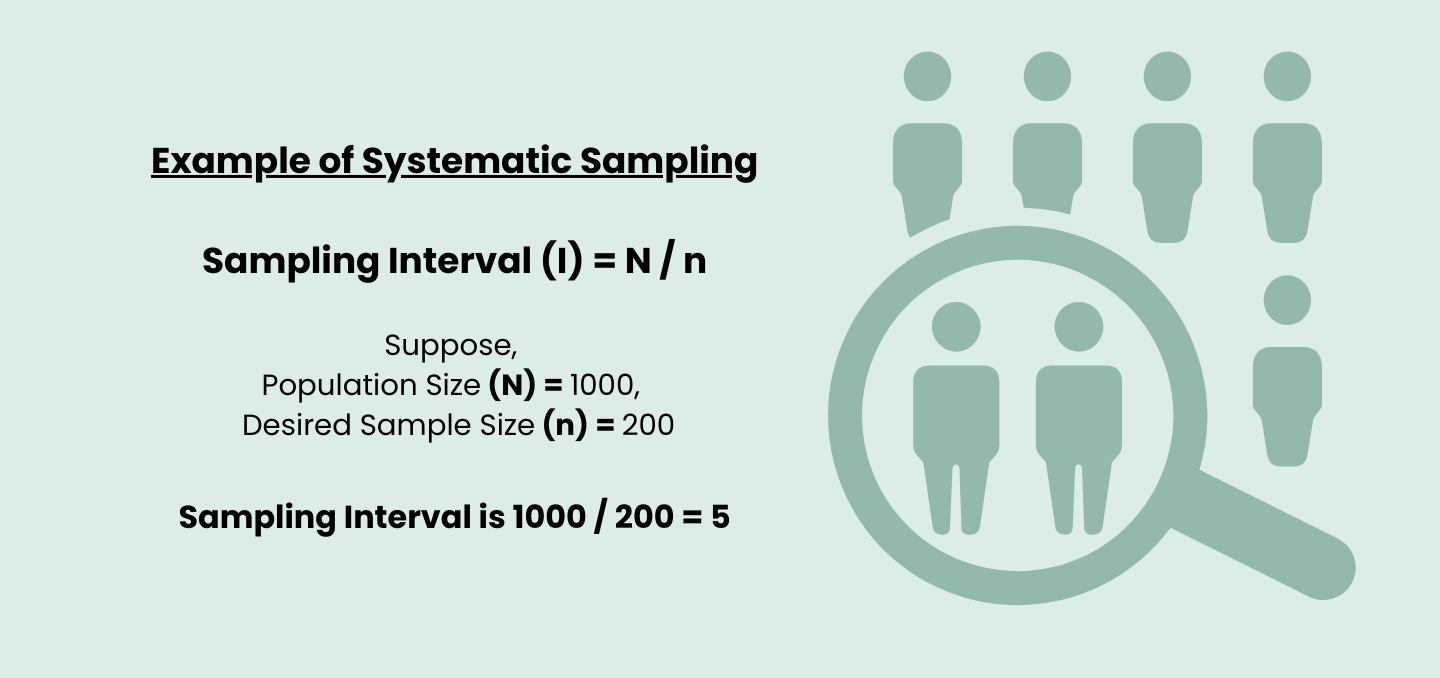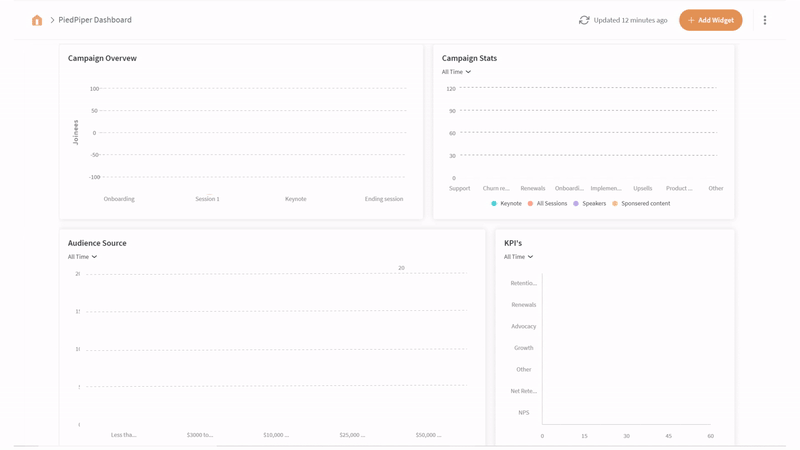Survey & Feedback
Systematic Sampling 101: Definition, Types and Examples
Article written by Parvathi Vijayamohan
Content marketer at SurveySparrow.
13 min read
19 September 2025

Need a guide to systematic sampling?
No worries — you’ll find all the details you need here. Click to jump ahead to the section that interests you.
- What is systematic method
- Example of systematic sampling
- 6 systematic sampling methods
- How to use systematic sampling
- When to use systematic sampling
- Advantages of systematic sampling
- The best tool to use
Let's get started!
What is Systematic Sampling?
In statistics, a sampling method is systematic if it involves selecting individuals or items for a sample in such a way that every nth item is selected.
These intervals are known as skip or sampling intervals. This interval is calculated by dividing the population size by the desired sample size.

So every 5th item will be selected for the sample.
Example of Systematic Sampling
To give you a clear idea of the concept, let's consider an example. The example provides insights into how systematic sampling can be applied in a real-world scenario.
Suppose a small business owner wants to gauge customer satisfaction for their online store. They have a total of 5,000 active accounts in their customer database.
Step 1 - Define the Population
The population here is. the active accounts, which is 5,000.
Step 2 - Determine Sample Size
The business owner decides to survey 10% of his customers, which is 500.
Step 3 - Calculate Sampling Interval
For this, we divide the population size by the desired sample size to get the sampling interval.
k = (N/n)
- k - sampling interval
- N - Sample size
- n - Total population
Therefore, k = 500/5000 = 10
This means that every 10th customer will be selected for the survey.
Step 4 - Choose a Random Starting Point
Here, you randomly select a number between 1 and 10 as the starting point. For example's sake, we are taking 3 as the number.
Now, if we consider 3 as the starting point, select every 10th customer thereafter. So, 3 then 13, 23, 33....493.
If you have taken 4, then the numbers would be 14, 24, 34, 44,...494.
Essentially, the process continues until 500 customers have been selected.
Systematic Sampling Methods: The Six Types (With Examples)
Each type of systematic sampling can be used for single or multi-phase surveys.
But before you go any further, you must consider a few things.
Sampling is not without its own challenges. There can be biases due to underlying patterns in the population or the need for an extensive, organized list. For this:
- Stop guessing which customers represent your entire audience.
- Start gathering representative feedback with the help of an Audience panel. And make sure you opt for a trusted panel. (We’ll come to this in a bit)
Now, it’s time to choose the right method.

1. Systematic Random Sampling
This is the most basic type. You just need to select from a random starting point but with a fixed, periodic sampling interval.
Example: Suppose a supermarket wants to study its customers’ buying habits.
With systematic random sampling, they can choose every 10th or 15th customer entering the supermarket. Then, they can conduct the study on this sample.
Learn More: Simple Random Sampling.
2. Stratified Systematic Sampling
Stratified sampling divides your audience into sub-groups called strata. Any characteristic can be the basis for this strata, like age, ethnicity, religion, etc. Then, using sampling intervals, you can choose sample members from each strata.
Example: Let’s say you’re researching the factors that influence consumer preferences towards bread.
Age does play a role here, so you would want to divide your audience into age groups like 18-25, 25-40 etc. From each strata, you can select individuals to study using sampling intervals.
3. Linear Systematic Sampling
This type treats the audience list as a fixed line divided at periodic sampling intervals. So once you reach the end of the line, you have exhausted your list and the sampling ends there.
This is a helpful sampling type if you require only a one-time sample and know exactly how many units are there in your audience.
Example: You are sampling for a work stress study within your organization between March-December, you can easily find out the current number of employees and apply the linear method.
4. Circular Systematic Sampling
This type treats the audience as a circular list. Once you reach the end of the list, you can continue the selection from the beginning. You can visualize this as a clock, with the hour lines symbolizing intervals.
Example: What if you have a huge population to draw from? Or you need multiple sets of samples?
This type of sampling is the best option. Because assuming the total audience is N, you can potentially get an N number of samples to work with.
5. Proportionate Systematic Sampling
In proportionate sampling, the sample size from each strata is proportional to the strata size.
Example: When you’re doing a student satisfaction survey among three classes of 30 students each. To save time, you choose proportional samples of 10 students from each class.
6. Disproportionate Systematic Sampling
This is a sampling method in which the size of the sample from a strata is not proportional to the relative size of that strata.
Example: Let’s say you’re doing a study of pizza sales in your city.
One strata could be fast food chains. Though they only account for 20% of all the pizza shops in your city, they get 70% of customer footfalls. So they will be disproportionately represented in your final sample.
Don’t worry we have the right tool to help you.

Get Started With Your Survey With AI in Seconds!
A personalized walkthrough by our experts. No strings attached!
How to Use Systematic Samples in 7 Simple Steps

Step 1: Select a Population and Determine Its Size
The first step in using systematic sampling is to identify the target population for your study. For instance, if you’re conducting a retail store study, your customers constitute the population of interest.
To determine the population size, you’ll need a comprehensive list of every customer who has shopped at the store during the relevant time period.
Step 2: Divide the Population into Subgroups or Strata
Once you have the population size, the next step is to divide it into smaller subgroups or strata of approximately equal size. This stratification ensures that the systematic sampling process covers the entire population in a representative manner, allowing you to draw more accurate and insightful conclusions.
Step 3: Decide Your Sample Size and Sampling Interval
Determining the appropriate sample size and sampling interval is crucial for a successful systematic sampling approach. This step involves using a formula, as mentioned earlier, to establish the right sample size and interval for your survey.
Step 4: Record Data with Survey Software
Once your sampling plan is in place, it’s time to conduct your survey and gather the necessary data. Utilizing survey software simplifies the data collection process, providing a user-friendly platform for respondents to participate in the survey effortlessly.
Step 5: Analyze Your Data Using Real-time Analysis
With data collection complete, the next step is to analyze the obtained data. Real-time analysis allows you to gain immediate insights into response trends, patterns, and other crucial metrics, empowering you to make informed decisions promptly.
Step 6: Form Conclusions Based on Analysis
Using the insights gained from the data analysis, you can draw meaningful conclusions about your target population. Visualizing the data and identifying key trends will make it easier to interpret the results accurately and draw actionable conclusions.
Step 7: Repeat Steps 2 through 6 with Another Sample Subgroup
To further enhance the robustness of your conclusions and validate your findings, it’s recommended to repeat steps 2 through 6 with another sample subgroup. This iterative process ensures comprehensive coverage of the entire population and strengthens the reliability of your study.

Get Started With Your Survey With AI in Seconds!
A personalized walkthrough by our experts. No strings attached!
Bonus Tip: Sample On-the-Spot with Observational Studies
Creating an exhaustive list of your audience can be time-consuming or even impractical in some cases. However, if you have the opportunity to physically observe your target audience, you can opt for on-the-spot sampling during the study. This approach allows you to adapt your systematic sampling strategy to suit your unique research needs.
Creating such a list can be time-consuming, if not impossible. So, if you are able to physically observe your audience, you can instead choose to sample them at the time of the study.
Example
In the context of a retail store study, one effective way to implement systematic sampling is by surveying every nth customer as they exit the store. This method ensures that each customer has an equal chance of being included in the sample, providing a representative cross-section of the store’s overall customer base.
However, to achieve a truly representative sample, it’s essential to consider the variation in customer types and their shopping patterns. Different customer segments may shop at varying times of the day and week.
For instance, need-based shoppers might frequent the store during lunch hours or later in the evening, while casual browsers tend to visit on weekends. To account for these variations, it’s important to allocate enough time for data collection and cover different time periods to capture the diversity of customers.
Despite best efforts, sometimes the in-store sampling alone might not yield a sufficiently diverse and representative sample. In such cases, turning to online panels can be a valuable solution.
Online panels provide access to a broader range of demographics, allowing you to target specific groups that may be underrepresented in the in-store sample. This approach ensures that you gather insights from the exact demographic you need, enhancing the overall quality and accuracy of your study.
By combining systematic sampling at the store with online panels, researchers can optimize their data collection process and achieve a more comprehensive understanding of their target audience. The integration of in-person and online sampling methods empowers businesses to make data-driven decisions that cater to the diverse needs and preferences of their customers.
When to Use Systematic Sampling?
With a lot of sampling types available, using the right one in the right circumstances can be the key. It's effective in various scenarios where its structured approach can enhance efficiency.
With that being in mind, let's see when you can use systematic sampling.

Scenario 1 - Budget Constraints
The best-case scenario where you can use systematic sampling is when there is a budget constraint. It can act as a cost-effective solution in such cases.
Unlike other sampling methods, this makes it affordable by lowering the resources required.
Scenario 2 - Time-Sensitive Research
If you want results quickly, then systematic sampling is a good choice. It expedites the data collection by selecting a small portion of the overall population.
Researchers can gather data more rapidly than with methods that require comprehensive sampling.
Scenario 3 - Homogeneous Populations
If you don't know, a homogeneous population is one where all members have the same or similar qualities. For example, a village where the population has remained remarkably similar in composition over time.
So, when this happens in large populations, systematic sampling is ideal. The method ensures that every member has an equal chance of selection. Thus, it is easier to manage and execute sampling in large datasets.
Scenario 4 - Low Variability in Population Characteristics
Low variability in population means that the characteristics of the population are relatively stable and consistent. When this happens, systematic sampling can yield reliable estimates with minimal bias. This is particularly useful in studies where the variability of responses is low.
4 Advantages of Using Systematic Sampling
Systematic sampling offers several advantages that make it a popular choice for researchers. Here are the key benefits.

1. Simplicity and Ease of Use
The method is straightforward to implement. Researchers only need to determine a sampling interval and select a random starting point. Thus, it is accessible even for those with limited statistical expertise.
2. Better Efficiency
With systematic sampling, you can speed up the sample selection and data analysis. Since it reduces the time and effort to gather data, the method is effective when dealing with a large population.
3. Reduced Bias
This sampling method reduces or minimizes the risk of bias. By selecting every kth individual, the process ensures that the sample is evenly spread across the population.
4. Uniform Coverage
This method ensures all segments are represented, providing a uniform coverage of the population. Following the method can be useful in a diverse population, as it helps capture a wide range of perspectives.
Get the Most Out of Systematic Sampling with SurveySparrow
If you’re looking to maximize the potential of your systematic sampling efforts, the executive dashboard feature and Tableau integration are essential tools in your arsenal.
With a user-friendly executive dashboard, you can gain real-time insights into your survey data, monitor responses, and track trends effortlessly. Define specific demographics or attributes you wish to include or exclude from your sample. Share your survey with the right audience, improving the quality and impact of your data.

When it comes to data visualization and analysis, the seamless integration with Tableau opens up a whole new world of possibilities. Unleash the power of data-driven decision-making with Surveysparrow and Tableau as you transform raw survey data into actionable insights that drive your business forward.
Draw statistically sound conclusions confidently! Sign up for free.
14-day free trial • Cancel Anytime • No Credit Card Required • No Strings Attached
FAQs on Systematic Sampling
When is it inappropriate to use systematic sampling?
Systematic sampling may not be suitable when the population exhibits a regular pattern or periodicity, leading to potential biases in the sample.
Why is systematic random sampling sometimes used in place of simple random sampling?
Systematic random sampling is chosen when efficiency is desired, as it requires a smaller sample size and is easier to implement than simple random sampling.
Why might a researcher choose purposive sampling over systematic sampling?
Researchers may opt for purposive sampling when they specifically target certain individuals or groups that possess unique characteristics or expertise.
When to use systematic sampling?
Appropriate for large populations with a known and organized structure, where equal representation of individuals is desired.
Wrapping up
That’s all, folks! Hopefully, after reading this article, you can determine the most appropriate method for your project.
So, let’s get started!
Perhaps SurveySparrow can help you. Whether you need an expert panel, data collection tool, feedback, and experience management platform, or if you wish to kickstart your survey creation journey, feel free to reach out!

Create engaging surveys that people actually complete. Try SurveySparrow now!
Parvathi Vijayamohan
Parvathi is a sociologist turned marketer. After 6 years as a copywriter, she pivoted to B2B, diving into growth marketing for SaaS. Now she uses content and conversion optimization to fuel growth - focusing on CX, reputation management and feedback methodology for businesses.
Related Articles

Survey & Feedback
How to Create a Facebook Survey in 2025: Step-by-Step Guide
17 MINUTES
23 June 2021

Survey & Feedback
Typeform vs Google Forms vs SurveyMonkey: Detailed Comparison in 2024
15 MINUTES
13 October 2020

Survey & Feedback
Election Polls 101: How to Conduct, Best Practices, Free Template
10 MINUTES
14 January 2022

Survey & Feedback
The ultimate 7 tips for getting more respondents for your survey
4 MINUTES
11 August 2019
